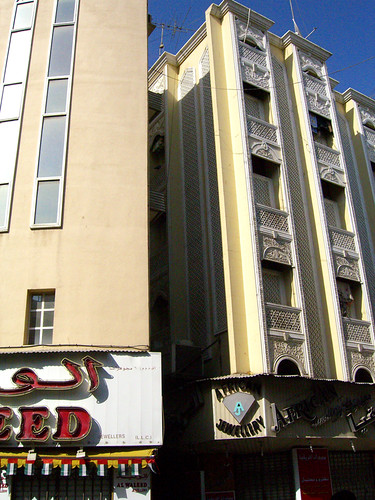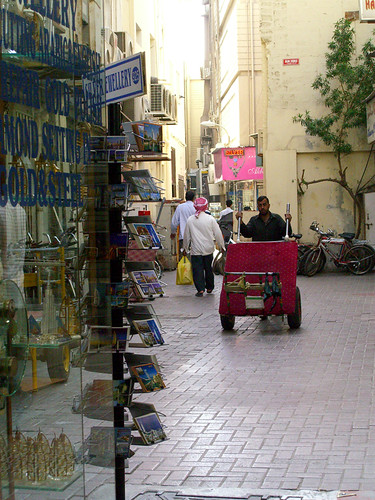
So what's behind the glitz and the glamour? Is there more to this oasis than record-breaking buildings and Maseratis? I remember a bazaar called a souk, by the water, where ladies in abayat, sari and jeans would haggle over golden bangles and spices instead of shopping at Tiffany and Carrefour. I remember my mother taking me to a fabric store that smelled of incense, where nearby we snacked on Indian samosas and sipped on hot chai. I remember sandy buildings with antennae branching from rooftops and gaudy glowing signs, advertising electronics and household goods in flowing Arabic and blocky English. Where did it all go? Was it all buried beneath construction sites like ancient relics?
I dragged Natasha into a cab and asked the driver to take us to the Gold Souk, which is where I thought as a child I was enchanted by glittery charms and barrels of saffron, but when we arrived, I wondered if in fact, it was the Spice Souk I had in mind. No matter, we had finally found Old Dubai.





There were only three things I wanted to do on this trip: walk in sand, buy a khamsa to ward off the evil eye, and eat a samosa. On the way to a silver shop, we passed a magenta-coloured hole in the wall café (if you can call it that) with a basket of samosas on the counter, and various other tasty Indian treats. I immediately popped inside, and found myself the centre of attention— everyone within this tiny shop was male, and it was as if none of them had ever seen a woman before, by the way I was being gawked at. I suddenly wished I was invisible, but my stomach's voice was far louder than my sense of fear, so I held my head up and ordered two samosas.
They were pretty good.

One of my favourite symbols, the khamsa, also known as the Hand of Fatima to Muslims or the Hand of Miriam to Jews, is a hand with an eye in its palm. The khamsa actually predates Islam and Judaism, and is thought to have originated with the ancient Phoenicians— although the eye in the hand is a common symbol in many ancient cultures. I could go on and on about the history of the khamsa— I once wrote a paper on the symbolism of Egyptian Bedouin jewellery which heavily featured the Hand of Fatima, but I'll instead tell you a brief little story about the khamsa in my life.
When I was around five or so, I was given a small gold khamsa with a turquoise eye on a delicate golden chain. I imagine my mother or one of my aunties gave it to me, but as I was very little, I don't remember exactly who.
I do remember wearing it proudly, loving the colour of the turquoise against the gold filigree fingers. It was one of my most prized possessions and it hung around my neck every day. One day the eye fell out and I was crushed— I was afraid to tell my mother because I felt I had done something bad, losing the eye— but I was told that the eye fell out because it had protected me from harm, that it fell out keeping me safe, which comforted me. My mother had the turquoise replaced with a green stone, and I continued to wear my khamsa until I got to that silly age when a child stops believing in the magic and preciousness of small things. I associate Dubai with that hand, and though I can find one in the bazaar in Istanbul, I wanted one from Dubai, and I found one— in a tiny silver shop where I was offered Indian chai, while I negotiated on a price.

Everywhere you look in Dubai, you see people from all over the world. According to Wikipedia, less than 20% of the emirate's population is composed of United Arab Emirates nationals— and about 85% of the expatriates living in Dubai come from Asia, most of them from India. Much of my memory of Dubai is coloured by saris, scented by curries and flavoured by chai.








1 comment:
it´s nice to take a look behind all the *sparkling* of Dubai :-)
Post a Comment